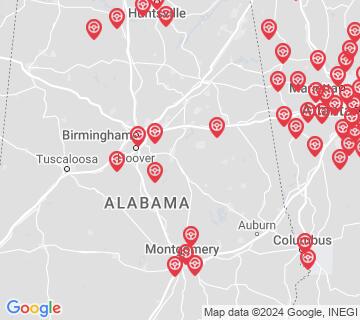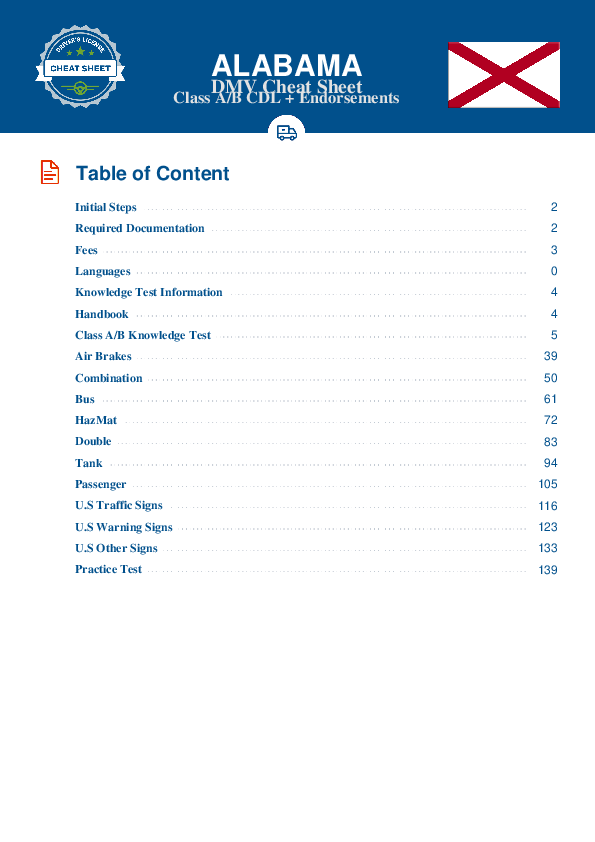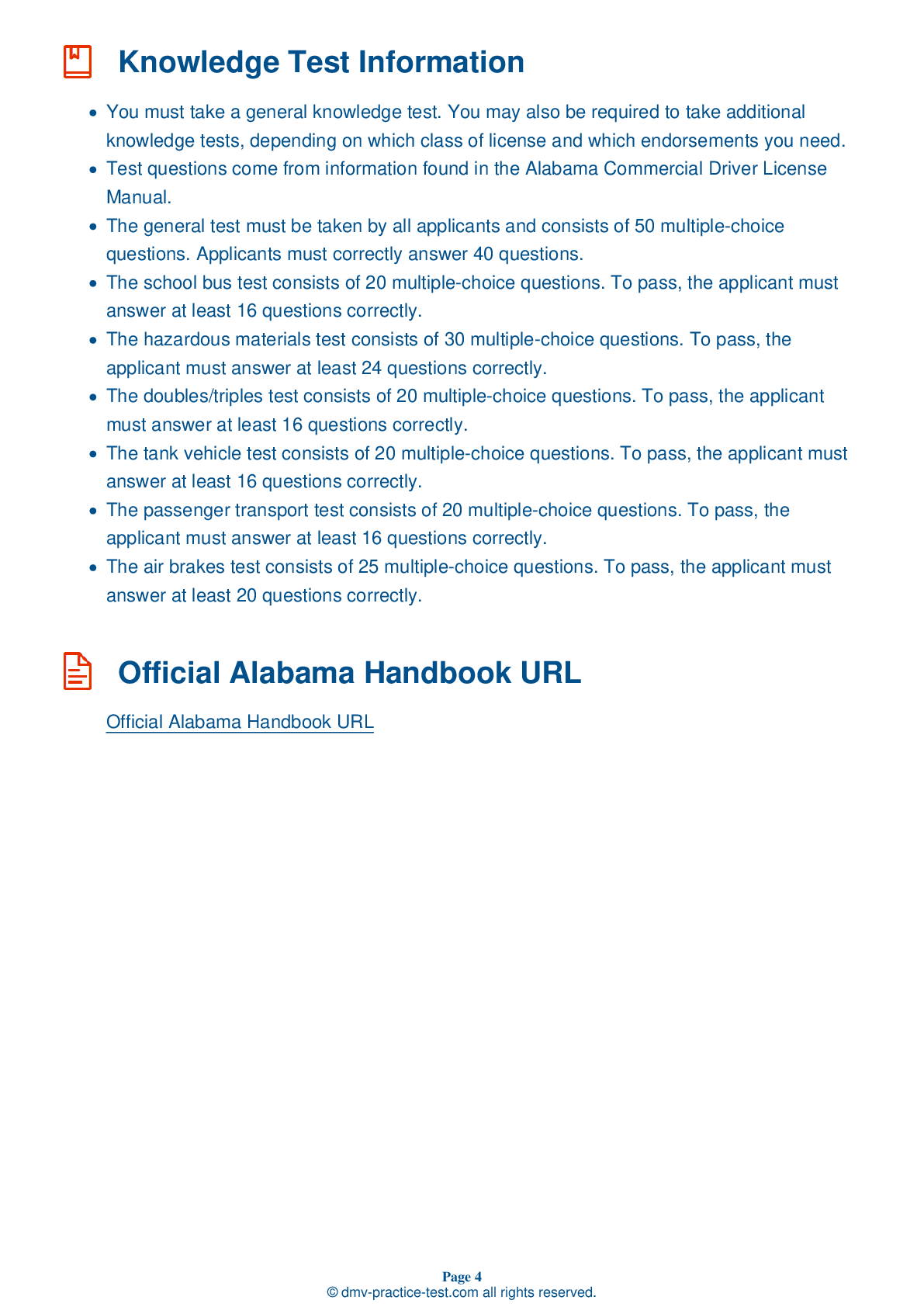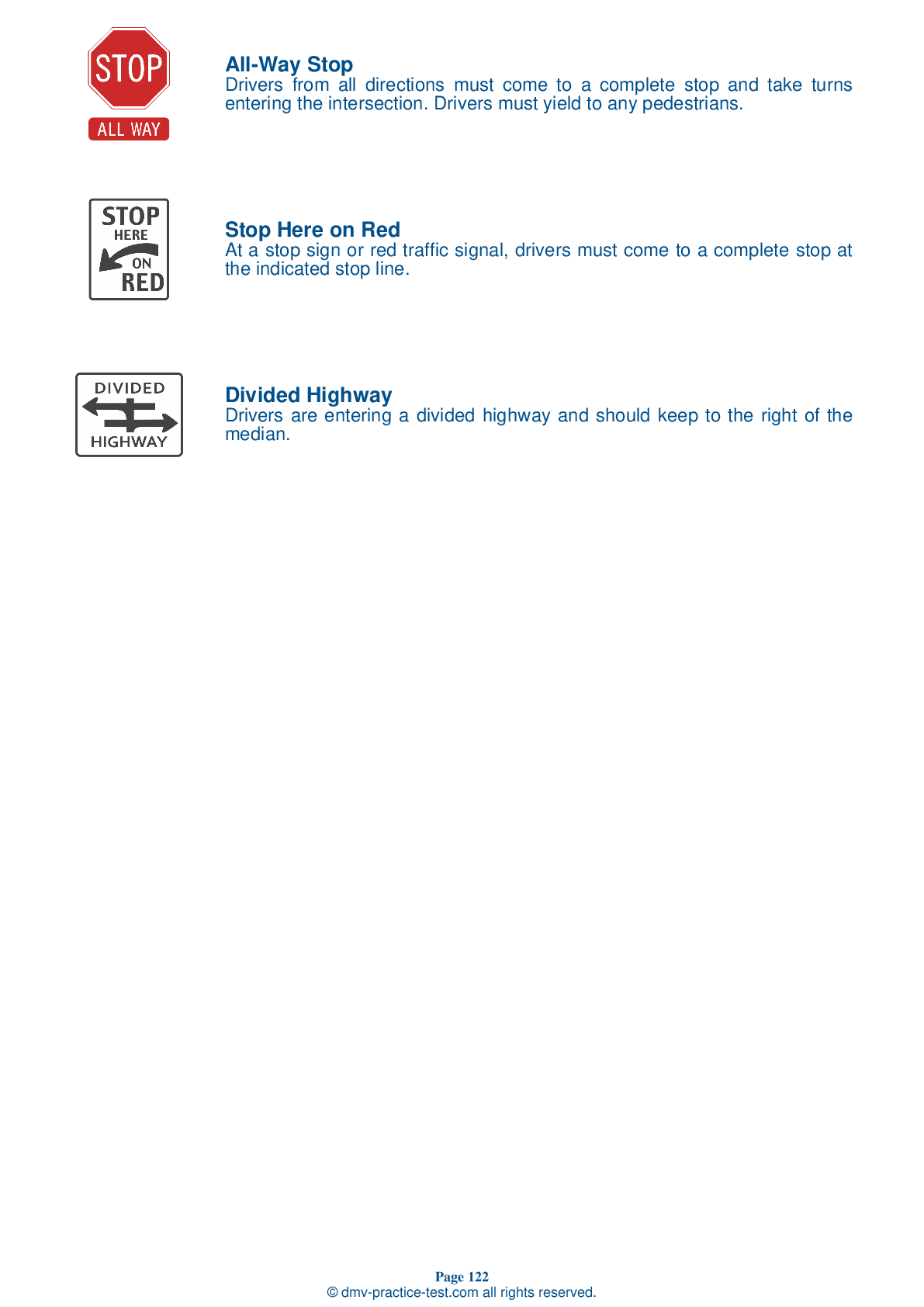Knowledge Test Class B #2
Class B Driving Test | Alabama 2025 #2
Train for FREE online with our Alabama class B license test. The official exam test consists of several obligatory parts, with all of them checking your knowledge of different blocks of road rules. If you need to obtain a AL CDL class B permit in 2025, practice as much as possible. Free sample tests published on our website will help you check and improve your knowledge and boost your grades. Please bear in mind that CDL class B requirements may vary from state to state.
50
40
20
1 . If a driver begins to feel fatigued while driving, they should:
Drive faster to finish the trip more quickly.
If you begin to feel drowsy while driving, the only safe response is to safely leave the road and get some sleep. Using artificial stimulants can be dangerous because they may cause extreme fatigue when they begin to wear off.
2 . If a load is 40 feet long, it should be secured by at least ____ tie-downs.
Cargo should be restrained by at least one tie-down for every 10 feet of cargo. However, all cargo should have at least two tie-downs, no matter the size of the cargo.
3 . If you are being tailgated, you should:
Allow the vehicle to pass.
If someone is tailgating you, it is a good idea to open up the space ahead of your vehicle to make it easier for the driver to pass you. Increasing your speed is not a good idea because the driver may continue to tailgate you at the higher speed, only increasing the danger.
4 . Which of the following is not acceptable emergency equipment?
Four yellow squares
During the vehicle inspection test, you will need to show emergency equipment, including spare electrical fuses; three red reflective triangles, six fuses, or three liquid burning flares; and a properly charged and rated fire extinguisher.
5 . What can change the height of a vehicle?
Number of windows
The added weight of a heavy load will make a vehicle sit lower than usual. A vehicle will often be taller when carrying a light load than when carrying a heavy load. If your vehicle fits under an overpass while carrying a full load, it is not guaranteed that it will fit under the same overpass if it is empty.
6 . The best way to avoid glare at night from oncoming vehicles is to:
Use your high beams.
To avoid being blinded by the lights of oncoming vehicles, you can glance to the right side of the road until the vehicle has passed.
7 . During an applied leakage test, the maximum leakage rate for a single vehicle with air brakes is:
4 psi in one minute.
It is important to know the maximum air loss rate that is safe for your specific vehicle. A single vehicle with air brakes should have a leakage rate no higher than 3 psi in a minute during an applied leakage test.
Search the best driving school in your neighbourhood
2025 Alabama | Frequently Asked Questions
To acquire a CDL Hazmat endorsement in Alabama, you must have a valid Alabama CDL. Next, pass the Hazardous Materials Endorsement Knowledge Test. Complete a background check and fingerprinting through the Transportation Security Administration (TSA). Finally, submit your application with the required fees to the Alabama Department of Public Safety. Training courses are recommended but not mandatory.
To obtain a CDL Hazmat license, you need to have a valid Commercial Driver's License (CDL). You must also pass the Hazardous Materials Endorsement Knowledge Test. Prior to applying for the endorsement, you must clear a TSA background check. Be aware that certain criminal offenses may disqualify you from obtaining the Hazmat endorsement.
When applying for a CDL Hazmat endorsement, you need to provide a completed application form, proof of U.S. citizenship or lawful permanent residency (like a passport or birth certificate), and your current valid Commercial Driver's License (CDL). A medical examiner's certificate may also be required. Lastly, you must pass the TSA background check and fingerprinting.
Yes, there is a dedicated written test for the CDL Hazmat endorsement. This test covers topics such as loading and unloading hazardous materials, bulk packaging marking, driving and parking rules, and emergency response procedures. Passing this test is mandatory for obtaining the Hazmat endorsement on your Commercial Driver's License (CDL).
The CDL Hazmat endorsement written test covers a range of subjects including: understanding the different types of hazardous materials and their associated risks, proper loading and unloading procedures, correct use of placards and labels, emergency response procedures in case of an incident, and regulations for transport of hazardous materials. It's designed to ensure drivers can safely handle hazardous cargo.
Yes, there are extra charges associated with obtaining a CDL Hazmat endorsement. In Alabama, the endorsement itself costs $20. However, you also need to account for the cost of the TSA background check and fingerprinting, which is approximately $86.50. These prices can vary slightly, so it's best to check the current fees when you apply.
Yes, to receive a CDL Hazmat endorsement, you're required to undergo a federal security threat assessment conducted by the Transportation Security Administration (TSA). This includes a fingerprint-based criminal history records check. The goal is to ensure that you don't pose a security threat and are fit to transport hazardous materials safely.
Yes, specialized training is required for a CDL Hazmat endorsement. This includes passing a written test covering hazardous materials regulations and safe handling procedures. Candidates must also pass a Transportation Security Administration (TSA) background check. While not mandatory, many choose to complete a training course to prepare for the test and handle hazardous materials safely.
No, you cannot transport hazardous materials without a valid CDL Hazmat endorsement in Alabama. The endorsement is required by federal law to ensure that drivers have the necessary knowledge and skills to safely transport hazardous materials. Driving without this endorsement could result in serious penalties, including fines and suspension of your CDL license.
Yes, you can add the CDL Hazmat endorsement to your existing CDL license. You don't need to apply for a new CDL. However, you must pass the Hazmat knowledge test, undergo a TSA background check, and pay the required fees. Once these steps are complete, the endorsement will be added to your current CDL license.




